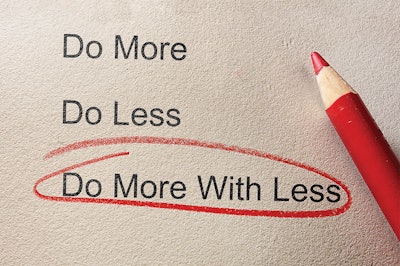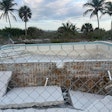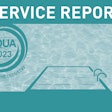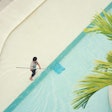
In times of dwinding labor (and the dreaded staff COVID outbreak), it’s more important than ever to keep your service crew running as efficiently as possible. But it’s not necessarily about having better or faster equipment, advises Mike Leone, founder of Pool Office Manager — it’s about cleaning up the business process itself.
“It’s not about saving two or three minutes at a job. That’d be great, but in reality, it’s not going to make a huge difference,” he says. “It’s about looking at the big picture of your business, where you may see inefficiencies…and finding sustainable changes that you can make no matter how many technicians you have on staff.”
Leone, an experienced business consultant, is no stranger to operational efficiency: He started his own pool service company in 2010 and has since found success by applying LEAN methodology.
“The main framework for LEAN is to define, measure, analyze, improve and control,” explains Leone. “A lot of it might feel like common sense, but sometimes it’s just putting these things in front of you and walking through the process.”
ELIMINATE WASTE
A good place to start is to identify problems, or forms of waste, in your operation. “Find those non-value add steps. An easy thing to say is, ‘What are my customers paying me to do?’” says Leone. “For example, they don’t pay you to invoice, they pay you to take care of their pool.”
Keep in mind that everything is not as it seems: Even if you decide that your invoicing is a problem, try digging deeper before diving into a solution right away. “Make sure you’re not wasting your time trying to solve a problem that might be caused by another problem,” Leone says. “Get to the root cause; get to that bottom level. Once you do and start to make changes, other problems may resolve themselves.”
Once you’ve gotten to the root of a problem, it’s time to set some metrics and targets to keep track of progress.
“Maybe I want invoices to go out no more than three days after we get the work done, that could be my metric,” says Leone. But don’t forget to monitor it, he warns. “People like to define their problems, come up with a solution, and then just keep doing what they’ve been doing. If you don’t measure things, you don’t know if you’re going to get any better.”
OPTIMIZE COMMUNICATION
Slow processes and misunderstandings can eat up a lot of time. “What does your communication network look like?” challenges Leone. “Is it a wheel? Does everyone have to go through one central person? Are you and your employees playing a game of telephone?”
He set his teams up with Slack to cut out unnecessary communication. The software essentially functions as channels of different group chats. This not only eliminates the middleman, but can also empower techs with the information they need to be successful.
“For example, we have a heater channel. If you’re working at a pool and you can’t get the heater to fire, we have our techs post their questions in the heater channel,” says Leone. “At the end of the year, I actually read through all of our heater questions and implement that in our training in the spring. It’s that simple. And it really helps you prepare for turnover. It makes a central repository for knowledge.”
SIMPLIFY PRICING
Leone remembers one service company that invoiced customers line by line, down to individual plugs. “You have to consider — what’s your customer’s perception when they get that invoice?” he says. “Are they reading line by line and just getting fired up to give you a phone call?”
Transparency is certainly a good thing, but this context, flat-rate packages and simple invoicing make things easier for both you and your customers.
“I call it the black hole of invoicing at the end of the month,” says Leone. “Some companies literally have someone in their office full-time, invoicing every day. Other companies do a prepaid package, $2,000 for the year, and send one invoice. In the end, who’s spending more time?”
To explain how he determines a flatrate price, Leone analogizes a casino. “If we’re all gambling here, the house needs to win. Otherwise, we’re going to go out of business,” he says. “So I price what I do at 80% of my time. At that 80th percentile, that’s 40 minutes for me. When I build my pricing, I go to that percentile because I know 80% of the time we’re going to take 40 minutes or less, which means not only am I making money, but I’m probably making more money than I anticipated…and of course, we do an exclusion. If we take over an hour, you can bill for the time over an hour.”
TWO-FOR-ONE
Consider cross-integrating your training with your service checklists. This can be as simple as setting up a Google form for crews to run through while they’re on the job.
“You can make this seamless. We don’t really need training guides anymore, because we can have our techs run through a checklist, and they know what they’re doing,” says Leone. “You might have 10 or 20 things — here’s what you do for an opening, here’s what you do for a closing.”
To prevent go-backs later on, some of those checkboxes could even require entry of serial numbers or equipment pad photos.
“Five to 10 minutes now, granted, will feel like it’s slowing you down. But when you think of the big picture, how many times would that information be nice to have?” says Leone. “It just saves you a lot of time on future business.”
ORGANIZE FOR ACCOUNTABILITY
When it comes to inventory, focus on error-proofing. Leone recommends making things visual with simple color coding, floor tape and a good shelving system.
“When there’s a designated place for things, it really makes things easier,” he says. “We now know where all our parts belong. We have a label I can walk by and read. I can see when the shelves are empty, and we might need to order something again. Before that, things were loose everywhere, and we couldn’t find parts.”
Beyond the warehouse, Leone prepares all of his trucks (and tool bags) in the same way, with each item in a designated spot.
“It doesn’t matter which technicians hop on which truck. They know where all their tools are,” he says. “Once you set this up, it just takes a bit of time to maintain it. Maybe you have to spend five or 10 minutes at the end of the week checking things and cleaning them out. But I’ll tell you this, making sure you have the right tool for every job is well worth any time that we’ve spent coming back.”
ITERATION IS KEY
After setting your metrics, be sure to continuously review them. “We are constantly iterating,” says Leone. “It’s just like starting a diet. You can work out in January and quit, or you can work out every month and see those results. So be patient with it.”
And don’t worry too much about hesitation from your staff: “Sometimes techs will be surprised if you make things easier for them. If they have a picture, they can reference the work done by the last guy who was there. And guess what? If they don’t have to call their manager five times a day, they’ll start to like it.”
This article first appeared in the March 2022 issue of AQUA Magazine — the top resource for retailers, builders and service pros in the pool and spa industry. Subscriptions to the print magazine are free to all industry professionals. Click here to subscribe.












































